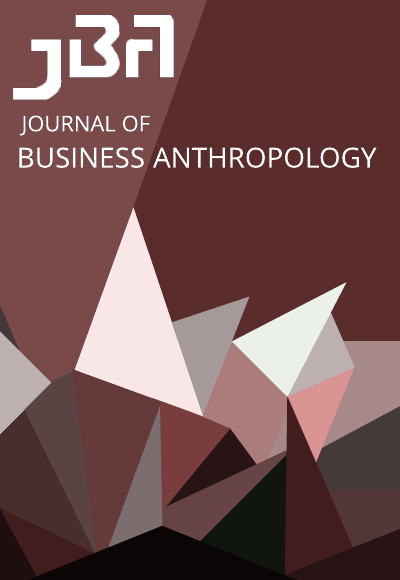Shifting Cases: Advancing a New Artifact for Entrepreneurial Education
DOI:
https://doi.org/10.22439/jba.v8i2.5849Abstract
Entrepreneurship, as applied here, involves helping students develop an entrepreneurial mindset by working in a university-supported startup that lacks the artificiality of a simulation or the safety net of heavy financial subsidization. This article chronicles an organizational-wide change at a private Midwestern university and the development of a new “artifact”—the dynamic case study—to complement a new approach to business and entrepreneurial education. After reviewing the function of case studies in a teaching and research context, I consider this new kind of case study as a boundary object and means for making sense of early stage entrepreneurial activity.
References
Anderson, A. 2005. Enacted Metaphor: The Theatricality of the Entrepreneurial Process, International Small Business Journal 23 (6): 587–603. https://doi.org/10.1177/0266242605057654
Crow, M. and W. Dabars. 2015. Designing the New American University. Baltimore, MD: Johns Hopkins University Press.
Dul, J., and T. Hak. 2007. Case Study Methodology in Business Research. New York, NY: Routledge.
Eisenhardt, K. 1989. Building Theories from Case Study Research, Academy of Management Review 14 (4): 532-550. https://doi.org/10.5465/amr.1989.4308385
Engeström, Y. 2014. Learning by Expanding: An Activity-Theoretical Approach to Developmental Research. New York, NY: Cambridge University Press. https://doi.org/10.1017/CBO9781139814744
Garcia-Lorenzo, L., P. Donnelly, L. Sell-Trujillo, and J. Miguel Imas. 2017. Liminal Entrepreneuring: The Creative Practices of Nascent Necessity Entrepreneurs, Organization Studies 39 (2-3): 373–395. https://doi.org/10.1177/0170840617727778
Gluesing, J. 2018. Using Boundary Objects to Facilitate Culture Change and Integrate a Global Top Management Team, Journal of Business Anthropology 7 (1): 32-50. https://doi.org/10.22439/jba.v7i1.5491
Lederman, D. 2017. The Culling of Higher Ed Begins, Inside Higher Ed. July 19. https://www.insidehighered.com/news/2017/07/19/numbercolleges-and-universities-drops-sharply-amid-economic-turmoil.
Marcus, J. 2017. Universities and Colleges Struggle to Stem Big Drops in Enrollment. The Hechinger Report. June 29. https://hechingerreport.org/universities-colleges-struggle-stem-bigdrops-enrollment/.
Maurya, A. 2012. Running Lean: Iterate from Plan A to a Plan That Works. Sebastopol, CA: O’Reilly Media, Inc.
Normand, Y. 2017. The History of the Case Study at Harvard Business School. HBX Business Blog. February 28. https://hbx.hbs.edu/blog/post/the-history-of-the-case-study-at-harvardbusiness-school.
Osterwalder, A., and Y. Pigneur. 2013. Business Model Generation: A Handbook for Visionaries, Game Changers, and Challengers. Hoboken, NJ: John Wiley & Sons.
Rencher, M. 2012. Crossing the Valley of Death: A Multi-Sited, Multi-Level Ethnographic Study of Growth Startups and Entrepreneurial Communities in Post-Industrial Detroit. Detroit, MI: Wayne State University.
Schramm, W. 1971. Notes on Case Studies of Instructional Media Projects. Stanford, CA: Stanford University, California Institute for Communication Research.
Star, S., and J. Griesemer. 1989. Institutional Ecology, Translations and Boundary Objects: Amateurs and Professionals in Berkeley's Museum of Vertebrate Zoology, 1907-39, Social Studies of Science 19 (3): 387–420. https://doi.org/10.1177/030631289019003001
Trompette, P., and D. Vinck. 2009. Revisiting the Notion of Boundary Object, Revue d’anthropologie des connaissances 3(1): 3-25.
Yin, R. 2013. Case Study Research: Design and Methods. Thousand Oaks, CA: SAGE Publications.
Downloads
Published
Issue
Section
License
Authors who publish with this journal agree to the following terms:
- Authors retain copyright and grant the journal right of first publication with the work simultaneously licensed under a Creative Commons Attribution License that allows others to share the work with an acknowledgement of the work's authorship and initial publication in this journal.
- Authors are able to enter into separate, additional contractual arrangements for the non-exclusive distribution of the journal's published version of the work (e.g., post it to an institutional repository or publish it in a book), with an acknowledgement of its initial publication in this journal.
- Authors are permitted and encouraged to post their work online (e.g., in institutional repositories or on their website) prior to and during the submission process, as it can lead to productive exchanges, as well as earlier and greater citation of published work (See The Effect of Open Access).



